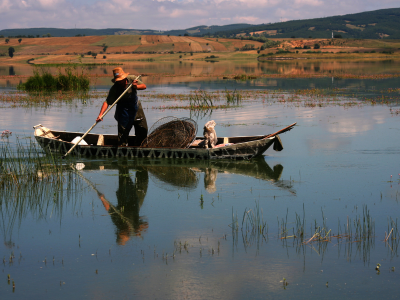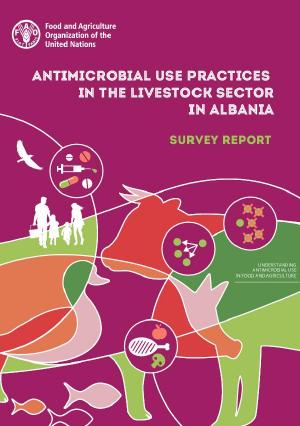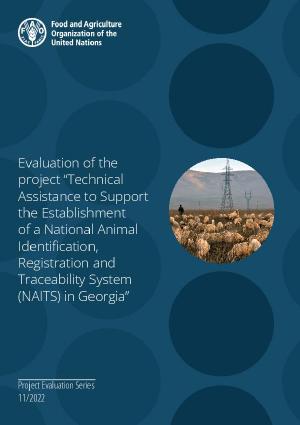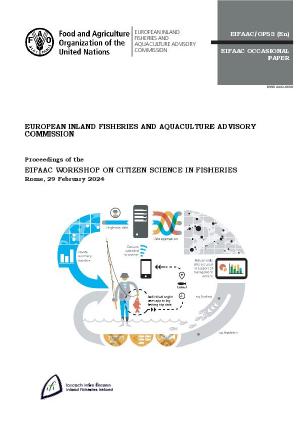
Europe and Central Asia Regional Overview of Food Security and Nutrition 2024
Managing water sustainably for improved food security and nutrition
This report provides the latest updates on hunger, food insecurity and malnutrition in Europe and Central Asia, including the cost and affordability of healthy diets. It also explores the central theme of water security, highlighting its critical connections to agriculture, food security and nutrition. While the region has made progress in reducing hunger and food insecurity (SDG Target 2.1), challenges remain in eliminating all forms of malnutrition (SDG Target 2.2).
Collections
- Country gender assessment series
- Digital agriculture
- Disaster risk reduction and management publication series
- Empowering smallholders and family farms series
- Transboundary animal diseases - Leaflets
Multimedia resources
Publications

Antimicrobial use practices in the livestock sector in Serbia
10/2024
The Understanding Antimicrobial Use in Food and Agriculture series is a compilation of country reports, each describing antimicrobial use (AMU) practices and awareness of antimicrobial resistance (AMR) in the livestock sector. This issue of the series summarizes the results of interviews performed in Serbia between June and October 2022.

Antimicrobial use practices in the livestock sector in Albania
11/2024
The Understanding Antimicrobial Use in Food and Agriculture series is a compilation of country reports, each describing antimicrobial use practices and awareness of antimicrobial resistance in the livestock sector. This issue of the series summarizes the results of interviews performed in Albania between June and November 2022.

Building resilience in urban food logistics systems
11/2024
This report explores the transformative impact of recent global disruptions on urban food logistics. Set against the backdrop of the COVID-19 pandemic and geopolitical tensions, it addresses critical challenges such as supply chain resilience, evolving consumer demand, and the need for sustainable infrastructure. It also presents best practices and trends in municipal investments and regulatory measures, aimed at enhancing food security in urban areas.

Digital Villages in Action: Europe and Central Asia
05/2023
The flyer details the activities that are ongoing as part of the digital Villages initiative in REU. Digital Villages enhance rural resilience and food security by providing farmers with digital tools for accessing inputs, market information, and alternative sales channels online. They deliver real-time data on prices, weather, and pests, enabling informed decisions on crop management and purchasing.

FAO’s role in humanitarian mine action
11/2024
The Food and Agriculture Organization of the United Nations (FAO) applies its technical expertise in humanitarian mine action to restore agricultural lands and enhance food security. By prioritizing demining efforts based on agricultural needs and mitigating soil contamination, FAO promotes sustainable recovery in affected areas. This document outlines FAO’s role in humanitarian mine action and its strategic approach to integrating agricultural recovery within mine action efforts.

Strengthening the status of the spouse and partner in Albania’s agricultural businesses
11/2024
In Albania, despite many positive policies and legal developments regarding gender equality, the ownership and management of agricultural businesses remain heavily male-dominated. This policy paper examines the experiences of three European Union countries – Belgium, France and Spain – to showcase good practices for enhancing the role and status of spouses and partners in agricultural businesses.

Gender-responsive value chain analysis in Albania: Case studies of Elbasan, Leskovik and Puka
10/2024
This publication employs FAO's gender-responsive value chain approach to analyze three case studies from Elbasan, Puka, and Leskovik. It highlights the opportunities for strengthening the role of women producers and processors in value chains and identifies key barriers that hinder women's full participation.

The state of food systems in the Black Sea Economic Cooperation Organization region
09/2024
Food systems in the member states of the Black Sea Economic Cooperation (BSEC) are changing quickly as economies grow, diets become less traditional and policies shift. This report seeks to provide an overview of key tendencies across diverse food systems in the region over the last decade.

Europe and Central Asia Gender Newsletter, July 2024 – Issue #15
08/2024
This edition of FAO Europe and Central Asia Gender Newsletter highlights the pivotal findings of FAO’s new report on women-responsive rural advisory services, critical updates on the revised Country Gender Assessment for Tajikistan, the story of a leading woman beekeeper from Uzbekistan, and the progress on climate resilient economic empowerment for women in Bosnia and Herzegovina.

FAO and Digital Agri Hub join forces to accelerate digital agriculture in Europe and Central Asia
05/2024
The Digital Agri Hub has established an important alliance with the Food and Agriculture Organization of the United Nations (FAO). Together, FAO and Digital Agri Hub are pooling their resources and expertise to accelerate the adoption and scaling up of digital solutions and services throughout Europe and Central Asia, with a focus on Low- and middle-income countries (LMICs).

Digitalization of the food control system to measure food safety in Georgia
01/2024
Effective data collection during food control procedures by the public authorities is essential to ensure food safety and compliance with regulations. Using modern technology plays a vital role in acquiring information from food businesses, food control inspections, and other food control actions.

Enhancing the Competitiveness of Agriculture in Georgia through Improved Food Safety and Animal Health Standards - GCP/GEO/009/SWI
06/2022
The project supported the development and rollout of a NAITS based on open source frameworks (to avoid present and future licensing costs), using modern digital technologies to minimize costs and provide the utmost flexibility, in compliance with the IT strategy of the MEPA. In parallel, the project deployed equipment for the intended users of the software and developed their capacities.

Evaluation of the project “Technical Assistance to Support the Establishment of a National Animal Identification, Registration and Traceability System (NAITS) in Georgia”
11/2022
This report presents the results of the final evaluation of the project “Technical Assistance to Support the Establishment of a National Animal Identification, Registration and Traceability System (NAITS) in Georgia” implemented from 1 December 2016 to 31 December 2021.

Guide on digital agricultural extension and advisory services
03/2023
Digital agricultural extension and advisory services (AEAS) have a great potential to enhance accessibility, delivery, transparency, scope and impacts of information and services for smallholder farmers. However, this potential is often unfully harnessed and the benefits of digital AEAS unequally distributed due to an evident, widening digital divide between rural and urban areas, gender, and different social groups both within and among regions.

Meeting the European Union's digital agriculture requirements
05/2024
The ITU Office for Europe and the FAO Regional Office for Europe and Central Asia co-authored this document to serve primarily as a compendium supporting the entry of EU pre-accession countries to the EU single market and the alignment of their agricultural policies with the emerging EU legislation related to digital agriculture, and more specifically, the CAP and its delivery.

Advancing the digital transformation of agriculture and rural areas through national strategies, e-Government systems, and Digital Villages - update for Europe and Central Asia - ECA/43/23/INF/4
08/2023
In response to the growing demand for seizing the opportunities brought by digital technologies, the FAO Regional Office for Europe and Central Asia has formulated a comprehensive regional action plan to integrate science and innovation and has introduced the Digital REU 2022–2030 approach. It emphasizes affordable and equitable access for rural communities and smallholder farmers, viewing technology as a catalyst for accelerating the sustainable transformation of agrifood systems.

Towards gender-responsive agricultural extension services in Albania: Assessment report
06/2024
This publication assesses the extent, progress and challenges of providing gender-responsive agricultural extension services in Albania based on the FAO Gender and Rural Advisory Services Assessment Tool (GRAST) methodology. This assessment identifies the key gaps at national, organizational and field levels that hinder the achievement of the relevant Sustainable Development Goals (SDGs) and the country’s progress towards inclusive and sustainable agrifood systems.

Promotion of geographical indication products: Learning from international experiences
07/2024
This book examines the importance and potential of geographical indication (GI) in Central Asia, drawing insights from global experiences in promoting GI products. It includes successful case studies and provides recommendations for Kyrgyzstan. It illustrates a number of good practices in the promotion of GIs and appellation of origin (AO) products by showing the quality and other positive impacts of geographical indication (GI) value chains.

Proceedings of the EIFAAC workshop on citizen science in fisheries
07/2024
The EIFAAC workshop on citizen science in fisheries was held virtually on 29 February 2024. It was organized by the EIFAAC Secretariat and Inland Fisheries Ireland. The workshop was attendedby 79 participants from 21 countries. Five invited speakers presented their citizen science research findings and recommendations.

Proceedings of the Sixth International Carp Conference
07/2024
The Sixth International Carp Conference was organized in Szarvas, Hungary, on 31 August–1 September 2023. The conference aimed to strengthen the “carp segment” within European aquaculture, improve the image of carp pond aquaculture as common European heritage, and to explore the opportunities for carp within “blue aquaculture”. The Sixth International Carp Conference approved the “Szarvas Declaration”.
